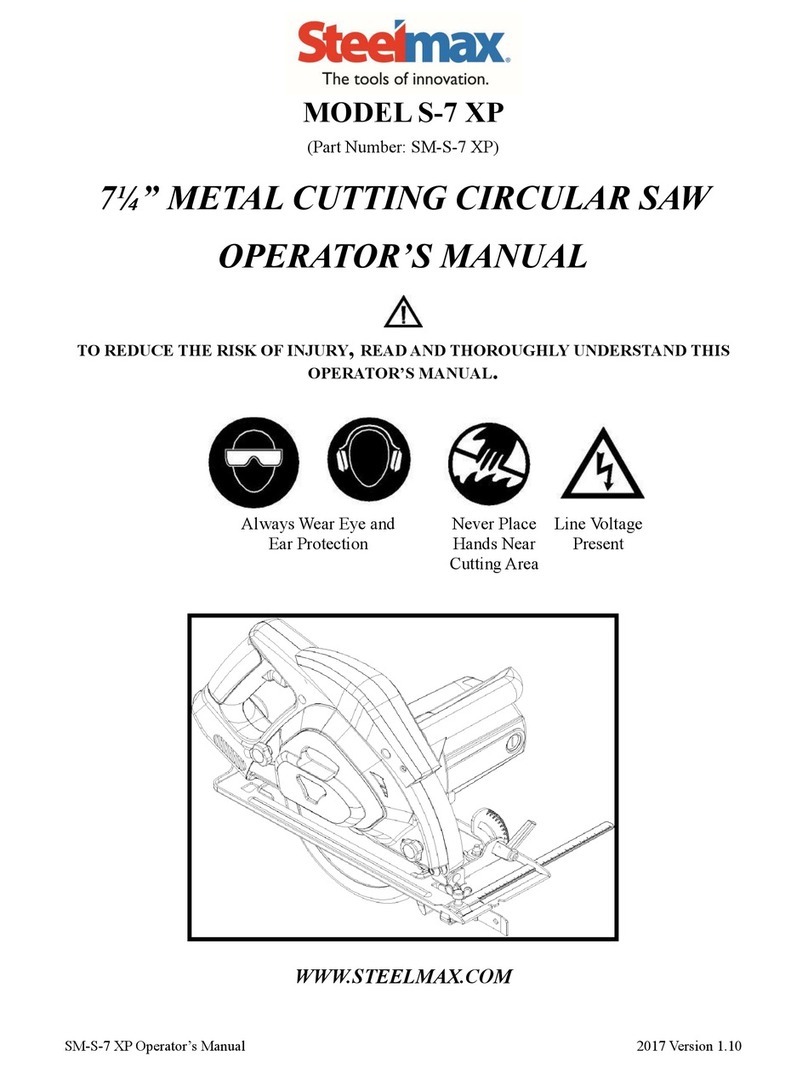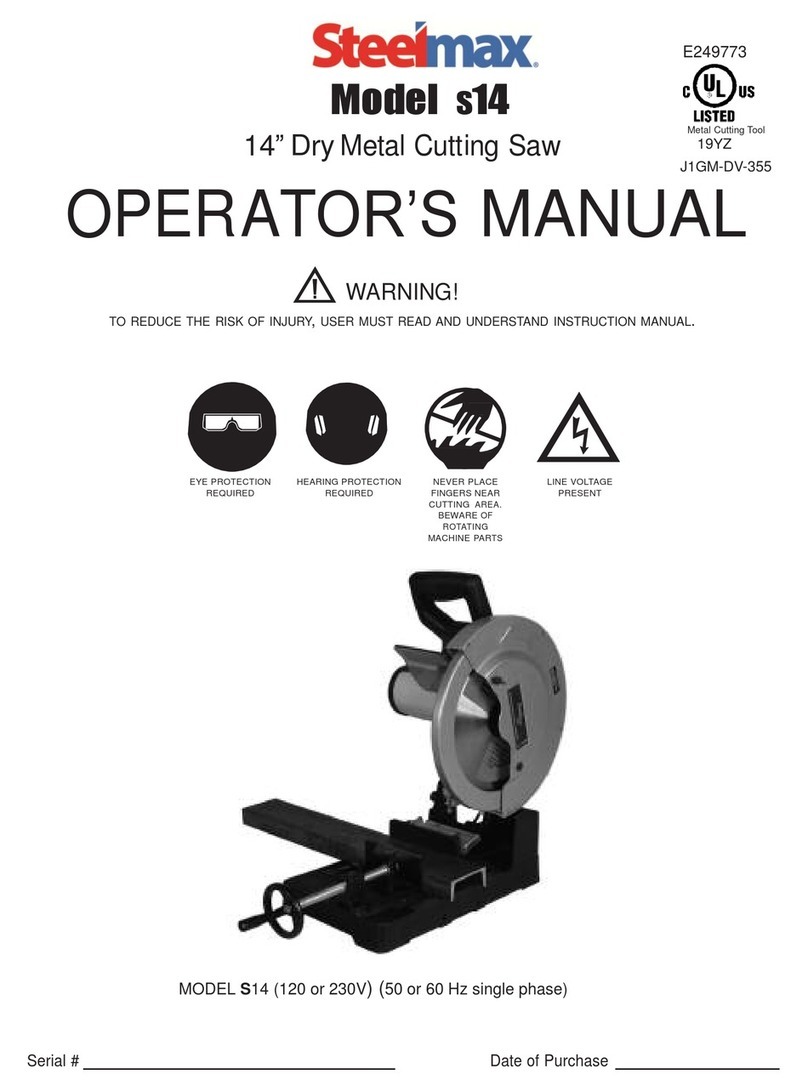SteelMax S9 User manual

M
o
d
Model
S
9
Portable Metal Cutting Circular Saw
OPERATOR’S MANUAL
WARNING!
TO REDUCE THE RISK OF INJURY, USER MUST READ AND UNDERSTAND THIS INSTRUCTION MANUAL.
EYE PROTECTION
REQUIRED
HEARINGPROTECTION
REQUIRED
NEVER PLACE
FINGERS NEAR
CUTTING AREA.
BEWARE OF
ROTATING
MACHINE PARTS
LINE VOLTAGE
PRESENT
MODEL
S
9 (120V)

2
Portable Metal Cutting Circular Saw
Congratulations on your purchase of a Steelmax®brand portable Metal Cutter Saw. Please complete and mail
your product registration card. Doing so will validate your machine’s warranty period and ensure prompt service if
needed. We Sincerely thank you for selecting a product from Steelmax.
TABLE OF CONTENTS
Limited Warranty
2
General Safety Rules
3
Specific Safety Rules and Symbols
5
Functional Drawing
11
Exploded View
12
Parts List
13
Assembly View
14
Operation
15
Operation (Laser
17
Emptying the Chip Chamber
18
Maintenance / Changing Saw Blades
19
Troubleshooting Checklist
20
Specifications / Accessories
21
LIMITED WARRANTY
Steelmax Tools LLC (STEELMAX) will, within twelve (12) months from the original date of purchase,
repair or replace any goods found to be defective in materials or workmanship, provided the product
warranty registration card has been returned to STEELMAX within thirty (30) days of purchase
date (proof of purchase required). This warranty is void if tool is used on materials thicker than
1/2" (13 mm) solid for aluminum, 1/2" (13mm) for mild steel, or 5/16" (8 mm) for solid stainless steel,
has been damaged by accident, neglect, improper service, or other causes not arising out of
defects in materials or workmanship. This warranty does not apply to machines and/or components
which have been altered, changed, or modified in any way, or subjected to use beyond recommended
capacities and specifications. Electrical components are subject to respective
manufacturers’ warranties. All goods returned defective shall be returned prepaid freight
to STEELMAX, which shall be the buyer’s sole and exclusive remedy for defective goods. In no
event shall STEELMAX be liable for loss or damage resulting directly or indirectly from the use of
merchandise or from any other cause. STEELMAX is not liable for any costs incurred on
such goods or consequential damages. No officer, employee or agent of STEELMAX is authorized to
make oral representations of fitness or to waive any of the foregoing terms of sale and none
shall be binding on STEELMAX.
STEELMAX RESERVES THE RIGHT TO MAKE IMPROVEMENTS AND MODIFICATIONS TO DESIGN
WITHOUT PRIOR NOTICE.
STEELMAX TOOLS LLC
6200 S. TROY CIRCLE, SUITE 110., CENTENNIAL, CO 80111

3
GENERAL SAFETY RULES
WARNING! Read and Understand all Instructions.
Failure to follow all instructions listed below, may result in electric shock, fire
and/or serious personal injury.
SAVE THESE INSTRUCTIONS
Work Area
•Keep Your Work Area Clean and Well Lit.
•Cluttered benches and dark areas invite accidents.
•Do not operate power tools in explosive atmospheres, such as in the presence of
flammable liquids, gases, or dust. Power tools create sparks which may ignite the dust
or fumes.
•Keep bystanders, children, and visitors away while operating a power tool. Distractions
can cause you to lose control.
Electrical Safety
•Grounded tools must be plugged into an outlet properly installed and grounded in
accordance with all codes and ordinances. Never remove the grounding prong or modify
the plug in any way. Do not use any adapter plugs. Check with a qualified electrician if
you are in doubt as to whether the outlet is properly grounded. If the tools should
electrically malfunction or break down, grounding provides a low resistance path to carry
electricity away from the user.
•Avoid body contact with grounded surfaces such as pipes, radiators, ranges and
refrigerators. There is an increased risk of electric shock if your body is grounded.
•Don’t expose power tools to wet or rainy conditions. Water entering a power
tool will increase the risk of electric shock.
•Do not abuse the cord. Never use the cord to carry the tools or pull the plug by the cord
from an outlet. Keep cord away from heat, oil, sharp edges or moving parts. Replace
damaged cords immediately. Damaged cords increase the risk of electric shock.
•When operating a power tool outside, use an outdoor extension cord marked "W-A" or
"W." These cords are rated for outdoor use and reduce the risk of electric shock.
•(Note) When using an extension cord, be sure to use one heavy enough to carry the
current your product will draw. An undersized cord will cause a drop in line voltage
resulting in loss of power and overheating. The recommended minimum is a 12 gauge
extension cord not exceeding 50 feet.

4
GENERAL SAFETY RULES
(continued)
Personal Safety
•Stay alert, watch what you are doing and use common sense when operating a power
tool. Do not use tool while tired or under the influence of drugs, alcohol or medication. A
moment of inattention while operating power tools may result in serious personal
injury.
•Dress properly. Do not wear loose clothing or jewelry. Contain long hair. Keep your hair,
clothing, and gloves away from moving parts.. Loose clothes, jewelry, or long hair can
be caught in moving parts.
•Avoid accidental starting. Be sure switch is off before plugging in. Carrying tools with
your finger on the switch or plugging in tools that have the switch on invites
accidents.
•Remove adjusting keys or switches before turning the tool on. A wrench or a key that is
left attached to a rotating part of the tool may result in personal injury.
•Do not overreach. Keep proper footing and balance at all times. Proper footing and
balance enables better control of the tool in unexpected situations.
•Use safety equipment. Always wear eye protection. Dust mask, non-skid safety shoes,
hard hat, and hearing protection must be used for appropriate conditions.
Tool Use and Care
•Use clamps or other practical way to secure and support the workpiece to a stable
platform. Holding the work by hand or against your body is unstable and may lead to loss
of control.
•Do not force tool. Use the correct tool for your application. The correct tool will do the
job better and safer at the rate for which it is designed.
•Any tool that cannot be controlled with the switch is dangerous and must be repaired. Do
not use the tool if switch does not turn it on or off.
•Disconnect the plug from the power source before making any adjustments, changing
accessories, or storing the tool. Such preventive safety measures reduce the risk of
starting the tool accidentally.
•Store idle tools out of reach of children and other untrained persons. Tools are dangerous
in the hands of untrained users.
•Maintain tools with care. Keep cutting tools sharp and clean. Properly maintained tools,
with sharp cutting edges are less likely to bind and are easier to control.
•Check for misalignment or binding of moving parts, breakage of parts, and any other
condition that may affect the tools operation. If damaged, have the tool serviced before
using. Many accidents are caused by poorly maintained tools.
•Use only accessories that are recommended by the manufacturer for your model.
Accessories that may be suitable for one tool, may become hazardous when used on
another tool.

5
SERVICE
•Tool service must be performed only by qualified repair personnel.
Service or maintenance performed by unqualified personnel could result in
a risk of injury.
•Follow instructions in the Maintenance section of this manual. When servicing a
tool, use only identical replacement parts. Use of unauthorized parts or failure to
follow Maintenance Instructions may create a risk of electric shock or injury.
SPECIFIC SAFETY RULES AND SYMBOLS
WARNING!
DO NOT OPERATE MACHINE IF WARNING AND/OR INSTRUCTION LABELS ARE MISSING OR
DAMAGED. CONTACT STEELMAX FOR REPLACEMENT LABELS. THE STANDARD LABELS
ARE SHOWN BELOW.
Table of contents
Other SteelMax Saw manuals























